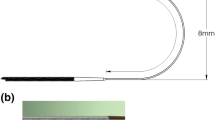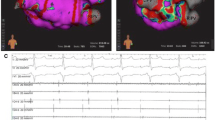Abstract
Objective
The number of transseptal punctures performed worldwide has increased exponentially with the development of ablation therapies for atrial arrhythmias. Safe access into the left atrium in these procedures is often complicated by abnormal anatomy. We assessed the potential of right atrial angiography to facilitate transseptal puncture for atrial ablation.
Methods and results
We examined all transseptal punctures performed for complex left atrial ablation in our centre over a 29-month period. In cases where conventional transseptal techniques failed, we performed orthogonal right atrial angiography to define cardiac anatomy and orientation. During the study period, 255 transseptal procedures were performed. Of these, 16 cases were complicated by distorted atrial anatomy, extreme cardiac rotation or unexpected location of the atria in relation to the diaphragm, preventing left atrial access using conventional fluoroscopy. The application of right atrial angiography facilitated successful transseptal puncture in all patients when use of conventional mapping catheters and fluoroscopy proved unhelpful. There were no complications relating to right atrial angiography.
Conclusion
These cases highlight a number of difficulties encountered when performing transseptal punctures. Previously reported adjunctive techniques require specialised equipment, general anaesthesia or multiple catheters that may be unavailable or impede the procedure. Right atrial angiography is a simple and safe adjunct to conventional techniques to facilitate complex transseptal procedures.
Similar content being viewed by others
References
Ross, Jr., J. (1958). Catheterization of the left heart through the interatrial septum. A new technique and its experimental evaluation. Surgical Forum, 9, 297–300.
Ho, S. Y., Sanchez-Quintana, D., Cabrera, J. A., & Anderson, R. H. (1999). Anatomy of the left atrium: Implications for radiofrequency ablation of atrial fibrillation. Journal of Cardiovascular Electrophysiology, 10, 1525–1533.
Brockenbrough, E. C., Braunwald, E., & Ross, Jr., J. (1962). Transseptal left heart catheterization: A review of 450 studies and description of an improved technic. Circulation, 25, 15–21.
Mullins, C. E. (1983). Transseptal left heart catheterization: Experience with a new technique in 520 pediatric and adult patients. Pediatric Cardiology, 4, 239–245.
Daoud, E. G. (2005). Transseptal catheterization. Heart Rhythm, 2(2), 212–214.
Manolis, A. S., Wang, P. J., & Estes, N. A. III. (1994). Radiofrequency ablation of left-sided accessory pathways: Transaortic versus transseptal approach. American Heart Journal, 128, 896–902.
Rocha, P., Berland, J., Rigaud, M., Fernandez, F., Bourdarias, J. P., & Letac, B. (1991). Fluoroscopic guidance in transseptal catheterization for percutaneous mitral balloon valvotomy. Catheterization and Cardiovascular Diagnosis, 23(3), 172–176.
De Ponti, R., Cappato, R., Curnis, A., Della Bella, P., Padeletti, L., Raviele, A., et al. (2006). Trans-septal catheterization in the electrophysiology laboratory: Data from a multicenter survey spanning 12 years. Journal of the American College of Cardiology, 47, 1037–1042.
Cappato, R., Calkins, H., Chen, S. A., Davies, W., Iesaka, Y., Kalman, J., et al. (2005). Worldwide survey on the methods, efficacy, and safety of catheter ablation for human atrial fibrillation. Circulation, 111, 1100–1105.
Roelke, M., Smith, A. J., & Palacios, I. F. (1994). The technique and safety of transseptal left heart catheterization: The Massachusetts General Hospital experience with 1279 procedures. Catheterization and Cardiovascular Diagnosis, 32, 332–339.
Scheinman, M. M. (1994). Patterns of catheter ablation practice in the United States: Results of the 1992 NASPE survey. Pacing and Clinical Electrophysiology, 17, 873–875.
Inoue, K. (1991). Percutaneous transvenous mitral commissurotomy using the Inoue balloon. European Heart Journal, 12B, 99–108.
Tucker, K. J., Curtis, A. B., Murphy, J., Conti, J. B., Kazakis, D. J., Geiser, E. A., et al. (1996). Transesophageal echocardiographic guidance of transseptal left heart catheterization during radiofrequency ablation of left-sided accessory pathways in humans. Pacing and Clinical Electrophysiology, 19(3), 272–281.
Hahn, K., Gal, R., Sarnoski, J., Kubota, J., Schmidt, D. H., & Bajwa, T. K. (1995). Transesophageal echocardiographically guided atrial transseptal catheterization in patients with normal-sized atria: Incidence of complications. Clinical Cardiology, 18(4), 217–220.
Daoud, E. G., Kalbfleisch, S. J., & Hummel, J. D. (1999). Intracardiac echocardiography to guide transseptal left heart catheterization for radiofrequency catheter ablation. Journal of Cardiovascular Electrophysiology, 10, 358–363.
Szili-Torok, T., Kimman, G. P., Theuns, D., Res, J., Roelandt, J. R., & Jordaens, L. J. (2001). Transseptal left heart catheterization guided by intracardiac echocardiography. Heart, 86, E11.
De Ponti, R., Zardini, M., Storti, C., Longobardi, M., & Salerno-Uriarte, J. A. (1998). Trans-septal catheterization for radiofrequency catheter ablation of cardiac arrhythmias. Results and safety of a simplified method. European Heart Journal, 19, 943–950.
Gonzalez, M. D., Otomo, K., Shah, N., Arruda, M. S., Beckman, K. J., Lazzara, R., et al. (2001). Transseptal left heart catheterization for cardiac ablation procedures. Journal of Interventional Cardiac Electrophysiology, 5(1), 89–95.
Ouyang, F., Bansch, D., Ernst, S., Schaumann, A., Hachiya, H., Chen, M., et al. (2004). Complete isolation of left atrium surrounding the pulmonary veins: New insights from the double-Lasso technique in paroxysmal atrial fibrillation. Circulation, 110(15), 2090–2096.
Author information
Authors and Affiliations
Corresponding author
Rights and permissions
About this article
Cite this article
Rogers, D.P.S., Lambiase, P.D., Dhinoja, M. et al. Right atrial angiography facilitates transseptal puncture for complex ablation in patients with unusual anatomy. J Interv Card Electrophysiol 17, 29–34 (2006). https://doi.org/10.1007/s10840-006-9058-9
Received:
Accepted:
Published:
Issue Date:
DOI: https://doi.org/10.1007/s10840-006-9058-9




